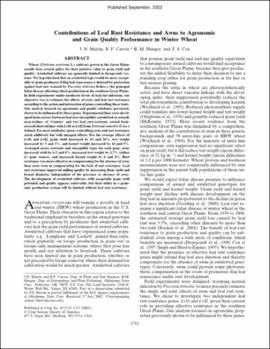| dc.contributor.author | Martin, J. N. | |
| dc.contributor.author | Carver, B. F. | |
| dc.contributor.author | Hunger, R. M. | |
| dc.contributor.author | Cox, T. S. | |
| dc.date.accessioned | 2015-10-16T20:47:51Z | |
| dc.date.available | 2015-10-16T20:47:51Z | |
| dc.date.issued | 2003-09 | |
| dc.identifier | okds_Carver_CS_2003-09.pdf | |
| dc.identifier.citation | Martin, J. N., Carver, B. F., Hunger, R. M., & Cox, T. S. (2003). Contributions of leaf rust resistance and awns to agronomic and grain quality performance in winter wheat. Crop Science, 43(5), 1712-1717. https://doi.org/10.2135/cropsci2003.1712 | |
| dc.identifier.uri | https://hdl.handle.net/11244/19800 | |
| dc.description.abstract | Wheat (Triticum aestivum L.) cultivars grown in the Great Plains usually bear awned spikes for their putative value to grain yield and quality. Awnletted cultivars are generally limited to forage-only systems. We hypothesized that an awnletted type would be more acceptable to grain producers if flag leaf senescence is delayed by protection against leaf rust (caused by Puccinia triticina Erikss.), the principal foliar disease affecting wheat production in the southern Great Plains. In field experiments under moderate levels of leaf rust infection, our objective was to estimate the effects of awns and leaf rust resistance according to the action and interaction of genes controlling these traits. Our analysis focused on agronomic and quality attributes previously shown to be influenced by these genes. Experimental lines were developed from crosses between leaf rust-susceptible (awnletted or awned) near-isolines of 'Century' and two leaf rust-resistant, awned backcrossed-derived lines with Lr41 or Lr42 from Triticum tauschii (Coss.) Schmal. For most attributes, genes controlling awns and rust resistance acted additively but with unequal effects. For the average effects of Lr41 and Lr42, grain yield increased by 63 and 26%, test weight increased by 5 and 3%, and kernel weight increased by 14 and 9%. Averaged across resistant and susceptible types for each gene, awns increased yield by 6.2 and 0%, increased test weight by 1.7% (either Lr gene source), and increased kernel weight by 6 and 4%. Rust resistance was more effective in compensating for the absence of awns than awns were in compensating for the lack of rust resistance. Leaf rust resistance improved milling quality by increasing flour yield and kernel diameter, independent of the presence or absence of awns. The development of awnletted cultivars with acceptable grain yield potential and quality appears achievable, but their utility in a grain-only production system will be limited without leaf rust resistance. | |
| dc.format | application/pdf | |
| dc.language | en_US | |
| dc.publisher | Crop Science Society of America | |
| dc.rights | This material has been previously published. In the Oklahoma State University Library's institutional repository this version is made available through the open access principles and the terms of agreement/consent between the author(s) and the publisher. The permission policy on the use, reproduction or distribution of the material falls under fair use for educational, scholarship, and research purposes. Contact Digital Resources and Discovery Services at lib-dls@okstate.edu or 405-744-9161 for further information. | |
| dc.title | Contributions of leaf rust resistance and awns to agronomic and grain quality performance in winter wheat | |
| osu.filename | okds_Carver_CS_2003-09.pdf | |
| dc.description.peerreview | Peer reviewed | |
| dc.identifier.doi | 10.2135/cropsci2003.1712 | |
| dc.description.department | Plant and Soil Sciences | |
| dc.description.department | Entomology and Plant Pathology | |
| dc.type.genre | Article | |
| dc.type.material | Text | |
